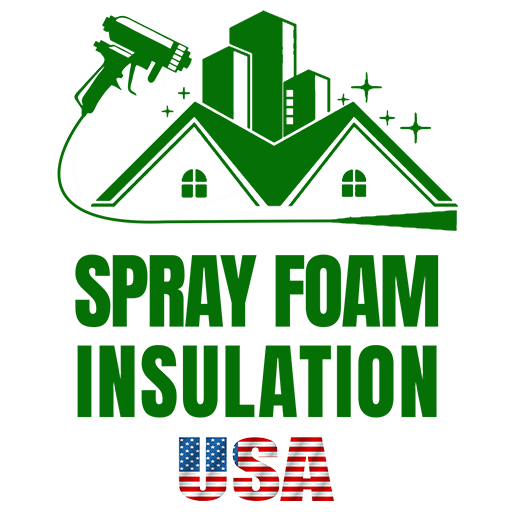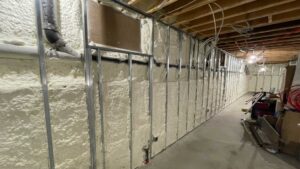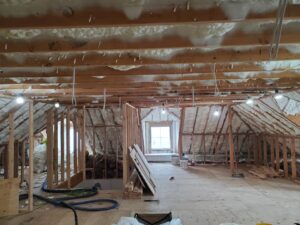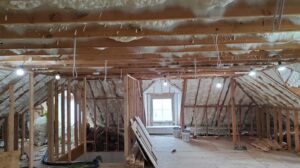Quick Cost Overview:
– DIY Kits: $40 – $850
– Professional Installation: A few thousand dollars depending on size and complexity
When it comes to cutting down your energy bills and making your home or business more energy-efficient, spray foam insulation is a top choice recommended by the US Department of Energy. But, how much does spray foam insulation actually cost? Whether you’re a homeowner in NY or NJ considering this eco-friendly solution or a business owner looking to enhance comfort and sustainability, understanding the costs is crucial.
Spray foam insulation can save you hundreds on yearly energy bills, with its ability to seal off air leaks and provide a high R-value for improved temperature regulation. However, the initial cost can seem high, with DIY projects starting from $40 up to $850 for larger kits, and professional installation climbing to a few thousand dollars. Yet, these costs are often offset by the long-term savings on your utility bills and the added comfort to your living or working space.
Whether you decide to go the DIY route for small projects or hire a professional for a full-scale installation, weigh the initial investment against the energy savings and increased comfort spray foam insulation brings to your property.
Understanding Spray Foam Insulation
When we dive into insulation, spray foam stands out for its unique properties and versatility. But what exactly makes it tick, and how do you decide which type is right for your home? Let’s break it down into simple terms.
Types of Spray Foam Insulation
There are two main types of spray foam insulation: open-cell and closed-cell. Each has its characteristics and uses.
-
Open-Cell Spray Foam: Imagine a sponge. This foam is softer and less dense, like the texture of a loaf of bread. It’s great for indoor spaces because it can trap air, making it a good insulator. Plus, it’s excellent for soundproofing.
-
Closed-Cell Spray Foam: Now, think of a hard, solid plastic. This foam is denser and more compact. It’s like a barrier that can block water and air. Because of its density, it adds strength to the walls it’s applied to.
Benefits of Spray Foam Insulation
- Energy Efficiency: Both types of spray foam insulation can help keep your home warmer in the winter and cooler in the summer. This means your heating and cooling systems don’t have to work as hard, saving you money on energy bills.
- Moisture Barrier: Closed-cell foam is particularly good at keeping water out. This can help prevent mold and mildew in your home.
- Soundproofing: Open-cell foam is softer and can absorb sound, making your home quieter.
- Longevity: Spray foam insulation can last a long time, up to 80 years or more, making it a wise investment for the future.
R-value
The R-value is a way to measure how well insulation can resist heat flow. The higher the R-value, the better the insulation material is at keeping heat in (or out). Closed-cell foam has a higher R-value than open-cell foam, meaning it’s more effective at insulating per inch of thickness.
Open-cell vs Closed-cell
- Open-Cell Foam is best for:
- Indoor use where moisture is not a big concern
- Soundproofing between rooms or floors
-
Places where a softer, more flexible insulation is needed
-
Closed-Cell Foam is best for:
- Areas prone to moisture, like basements and crawl spaces
- Adding structural strength to walls
- Outdoor or roofing applications due to its moisture-blocking capabilities
In summary, the choice between open-cell and closed-cell spray foam insulation depends on your specific needs. Consider factors like moisture exposure, the need for soundproofing, and energy efficiency desires when making your decision. No matter which type you choose, spray foam insulation is a powerful tool for enhancing your home’s comfort and energy performance.
Major Cost Factors of Spray Foam Insulation
When planning for spray foam insulation, understand the main elements that influence the overall cost. Here’s a simple breakdown to help you navigate through the process.
Project Size
The size of your project is a big deal. Think of it like buying in bulk; the more you need, the more it costs. But, the cost per unit (in this case, per square foot) might get lower as the project size increases.
Location in Home
Where you’re adding insulation matters a lot. Different areas of your home have different needs. For instance, attics may require thicker insulation compared to walls, affecting the price. Hard-to-reach spots might also bump up the cost due to the extra work needed to get there.
Type of Spray Foam
There are two main types: open-cell and closed-cell. Closed-cell is denser, offers better moisture resistance, and has a higher R-value but comes with a higher price tag. Open-cell, while cheaper, is best suited for dry, interior spaces due to its lower density and moisture resistance.
Thickness
Thicker insulation means more material, which means higher costs. But, it also means better insulation. You’ll need to balance the immediate cost with the long-term energy savings you’re aiming for. More isn’t always better, but too little might not give you the efficiency you need.
Labor Costs
Finally, who installs the insulation can make a big difference. Doing it yourself might seem cheaper, but without the right skills, you could end up paying more in the long run due to mistakes. Professional installers know what they’re doing, but their expertise comes at a price. This cost varies significantly based on where you live and the complexity of your project.
While the initial outlay for spray foam insulation might seem high, the energy savings over time can make it a worthwhile investment. When asking ‘how much does spray foam insulation cost,’ consider not just the immediate price but the long-term benefits as well.
Moving forward, let’s dive into the specifics of open-cell and closed-cell spray foam insulation costs and benefits, helping you make an informed decision for your home.
Cost Breakdown by Type of Spray Foam Insulation
Understanding the cost and benefits of different types of spray foam insulation is key to making an informed choice. Let’s break it down.
Open-Cell Spray Foam Insulation
- Cost per board foot: Open-cell spray foam insulation typically costs between $0.44 and $0.75 per board foot.
- R-value: It has an R-value of about R-3.5 per inch. This means it’s good at insulating, but not as powerful as closed-cell foam.
- Ideal locations: Because of its ability to fill nooks and crannies, it’s great for interior walls and attics where a moisture barrier isn’t a top priority.
Open-cell foam is the softer option, making it excellent for soundproofing. It’s also more affordable, which makes it attractive for large areas that need insulation without breaking the bank. However, its lower density means it doesn’t block moisture as effectively as closed-cell foam.
Closed-Cell Spray Foam Insulation
- Cost per board foot: Closed-cell foam is pricier, with costs ranging from $1 to $1.60 per board foot.
- Higher R-value: With an R-value of R-6 to R-7 per inch, closed-cell foam offers superior insulation and can significantly reduce energy bills.
- Moisture resistance: Its dense structure makes it an excellent moisture barrier, protecting your home from mold and water damage.
Closed-cell foam’s higher cost comes with increased benefits. It’s ideal for basements, crawl spaces, and exterior walls where moisture resistance is crucial. Despite the higher upfront cost, its durability and efficiency can provide savings in the long run.
Choosing the Right Type for Your Home
When deciding between open-cell and closed-cell spray foam insulation, consider your home’s specific needs. Open-cell foam is cost-effective and great for interior applications, offering sound dampening benefits. Closed-cell foam, while more expensive, provides unmatched moisture resistance and thermal insulation, making it suitable for areas prone to dampness or where higher insulation levels are required.
By understanding the cost per board foot, R-value, and ideal locations for each type of spray foam insulation, you can make a decision that balances cost with benefits. Whether you choose open-cell for its affordability and ease of application or closed-cell for its superior insulation and moisture barrier properties, spray foam insulation is a smart investment towards energy efficiency and comfort in your home.
Next, we’ll explore the pros and cons of DIY versus professional spray foam insulation installation, to further guide you in making the best choice for your insulation project.
DIY vs. Professional Installation
When it comes to insulating your home with spray foam, the decision between doing it yourself (DIY) and hiring professionals is crucial. Both options have their merits and challenges. Below, we break down the key aspects of each to help you make an informed choice.
Professional Spray Foam Insulation
Contractor Charges: Hiring a professional can seem costly at first glance. The price includes not just the materials but also the labor, expertise, and equipment. While this can add up, professionals bring a level of precision and efficiency that’s hard to match on your own.
Benefits of Professional Installation:
– Speed and Efficiency: Professionals can complete the job quickly, thanks to their experience and specialized tools.
– Quality: With their training and expertise, professionals know how to evenly apply spray foam to avoid gaps and ensure optimal insulation.
– Warranty: Many contractors offer warranties on their work, giving you peace of mind and protection against future issues.
Building Codes: A professional installer is familiar with local building codes and regulations. This knowledge is crucial to ensure that your insulation project complies with the law and safety standards, avoiding potential fines or complications down the line.
DIY Spray Foam Insulation
Kits Cost: DIY spray foam kits can range from $40 for small projects to $850 for larger ones. While the upfront cost might be lower compared to hiring a professional, it’s important to consider the full scope of the project and the potential for additional expenses due to mistakes or inadequate coverage.
Protective Gear: Safety is paramount when applying spray foam insulation yourself. You’ll need to invest in proper protective gear, including a respirator mask, gloves, goggles, and possibly a full-body suit, to protect yourself from the chemicals involved.
Complexity of the Job: Spray foam insulation can be tricky to apply correctly. It expands rapidly and needs to be applied evenly to avoid gaps and ensure effective insulation. The complexity of preparing the area, managing the equipment, and applying the foam evenly should not be underestimated.
Making the Decision:
Choosing between DIY and professional installation comes down to a few key factors:
– Skill Level: If you’re comfortable with home improvement projects and have the necessary safety equipment, a DIY approach might be feasible for smaller areas.
– Project Size and Complexity: For larger projects or areas that require precise application (like attics or crawl spaces), professional installation is likely the better choice.
– Cost vs. Quality: While DIY may offer initial savings, the long-term benefits of professional installation, such as efficiency, durability, and the peace of mind that comes with a warranty, often outweigh the upfront costs.
In conclusion, while DIY spray foam insulation can be a cost-effective option for small, straightforward projects, the complexities and potential risks involved make professional installation the safer and more reliable choice for most homeowners. With their expertise, adherence to building codes, and ability to quickly complete the job, professionals ensure that your insulation is installed correctly, providing you with long-term energy savings and comfort.
Moving forward, let’s delve into additional factors that can affect the cost of your spray foam insulation project, ensuring you have all the information needed to make an informed decision.
Additional Factors Affecting Costs
When considering how much does spray foam insulation cost, look beyond just the basic installation. Several factors can influence the final price tag, making your project more or less expensive. Let’s break down these additional costs:
New Construction vs. Existing Home
-
New Construction: Typically, insulating a brand-new home costs less — ranging from $2.75 to $6.50 per square foot. Why? Because it’s easier to apply spray foam in open spaces before the walls and ceilings are sealed up. Plus, there’s no need to remove old insulation or make space for the new material.
-
Existing Home: Retrofitting spray foam insulation into an existing structure tends to be more expensive, with costs between $3.15 to $7.50 per square foot. The complexity of working around existing walls, electrical systems, and plumbing increases the labor involved, pushing up the price.
Mold Removal
Water intrusion can lead to mold growth within your walls or attic. If this occurs, simply replacing insulation isn’t enough. Mold remediation is often necessary to remove contaminated materials and ensure the air in your home is safe to breathe. This process can add $1,500 to $3,500 to your project’s cost. It’s a crucial step for maintaining a healthy home environment.
Vapor Barrier Installation
In areas with high humidity or lots of rain, spray foam alone might not suffice to keep moisture at bay. Adding a vapor barrier can provide an extra layer of protection against dampness, for an additional $0.65 to $1.00 per square foot. This barrier helps prevent moisture from penetrating your home, protecting against water damage and mold growth.
Understanding these factors is vital for anyone asking, “how much does spray foam insulation cost?” By considering the type of construction, potential mold issues, and the need for a vapor barrier, you can better estimate the overall cost of your insulation project. While these additional costs can increase your upfront investment, they also contribute to the long-term health, comfort, and energy efficiency of your home.
In the next section, we’ll explore the undeniable benefits of choosing spray foam insulation, from its superior energy efficiency to its role as a moisture barrier and soundproofing agent.
Benefits of Choosing Spray Foam Insulation
When it comes to insulating your home, spray foam insulation stands out for several compelling reasons. Let’s dive into the key benefits that make it a top choice for homeowners.
Energy Efficiency
One of the most significant advantages of spray foam insulation is its energy efficiency. Unlike traditional insulation materials, spray foam expands to fill gaps and crevices, creating an airtight seal. This means less warm air escapes in the winter and less cool air leaks out in the summer. As a result, your HVAC system doesn’t have to work as hard, leading to lower utility bills. In fact, the US Department of Energy suggests that proper insulation can save you up to 20% on heating and cooling costs.
Moisture Barrier
Water and moisture can wreak havoc on a home, leading to mold growth and structural damage. Here’s where spray foam insulation shines again. Closed-cell spray foam acts as an effective moisture barrier, repelling water and preventing moisture from seeping into and through your walls. This can be particularly important in areas prone to flooding or high humidity.
Soundproofing
Noise pollution can disturb the peace of your home. Whether it’s traffic noise, loud neighbors, or other sounds from outside, spray foam insulation can help. By sealing off gaps and cracks, it reduces the amount of sound that can enter your home, creating a quieter and more peaceful living environment. This soundproofing quality is an added bonus on top of its insulating properties.
Longevity
Spray foam insulation is not just a short-term solution. It’s designed to last, offering durability that can extend up to 80 years or more. Unlike other types of insulation that may sag or settle over time, spray foam maintains its shape and effectiveness, ensuring your home remains well-insulated for decades. This long lifespan makes it a cost-effective choice in the long run, despite the higher initial investment.
In Summary
Choosing spray foam insulation for your home comes with a host of benefits:
- Energy Efficiency: Saves on heating and cooling costs by creating an airtight seal.
- Moisture Barrier: Protects against water damage and mold growth.
- Soundproofing: Offers a quieter home by reducing the entry of external noises.
- Longevity: Provides a long-lasting insulation solution that doesn’t degrade over time.
While the upfront cost of spray foam insulation may be higher compared to other types, the long-term savings, durability, and added comfort it brings to your home make it a worthwhile investment. Whether you’re looking to reduce your energy bills, protect your home from moisture, enjoy a quieter living space, or simply invest in a long-term solution, spray foam insulation delivers on all fronts.
In the next section, we’ll explore ways to reduce the costs associated with spray foam insulation, ensuring you can enjoy these benefits without breaking the bank.
How to Reduce Spray Foam Insulation Costs
When considering how much does spray foam insulation cost, it’s equally important to think about how you can lower those costs. Here are some strategies to help you save money on spray foam insulation without compromising on quality or performance.
Open-Cell in Dry Areas
Choosing the right type of spray foam insulation for the right area can significantly affect the cost. For areas in your home that are less prone to moisture—like interior walls or attics not exposed to leaks—open-cell spray foam is a cost-effective choice. It’s less expensive than closed-cell foam and still provides excellent insulation and air sealing. Since open-cell foam expands more, it covers larger areas with less material, which can also help reduce costs.
Acting as Your Own General Contractor
If you’re comfortable managing a project and coordinating between different specialists, acting as your own general contractor can save you a significant amount on labor costs. This approach requires more of your time and attention but allows you to negotiate directly with subcontractors and potentially get better rates for the work. Just keep in mind that this route requires a good understanding of construction processes and the ability to manage timelines effectively.
Tax Credits, State and Local Rebates
Governments often encourage energy-efficient home improvements through tax credits and rebates. By installing spray foam insulation, you might qualify for these incentives, which can substantially lower your net cost. The Database of State Incentives for Renewables & Efficiency (DSIRE) is an excellent resource for finding out what incentives are available in your area. These programs can change, so it’s important to check for the most current information.
State and Local Rebates
In addition to federal tax credits, many states, cities, and utility companies offer rebates for energy-efficient improvements. These rebates can cover a portion of the cost of materials and installation for spray foam insulation. The specifics vary widely depending on where you live, so contact your local utility company or visit your state’s energy office website for more information.
By considering these cost-saving measures, you can make spray foam insulation a more affordable option for your home. The initial investment in spray foam pays off over time through lower energy bills and a more comfortable living environment. So, while the upfront costs might seem high, the long-term savings and benefits are well worth it.
Keep these tips in mind to make the most out of your investment in spray foam insulation. With a little planning and research, you can enjoy all the advantages of spray foam without stretching your budget too thin.
Frequently Asked Questions about Spray Foam Insulation
When it comes to making a decision about insulating your home, you’re bound to have questions. Let’s tackle some of the most common queries about spray foam insulation to give you a clearer picture.
Is spray foam worth the money?
Absolutely. While the initial cost might seem higher compared to traditional insulation methods, the benefits far outweigh this initial investment. Spray foam insulation not only seals your home from air and moisture leakage but also adds to the structural integrity of your home. This leads to significant energy savings over time, potentially reducing your utility bills by up to 50% according to some estimates.
Moreover, because spray foam insulation is so effective at maintaining a consistent temperature, your home becomes more comfortable year-round. This improvement in energy efficiency and comfort can also increase your property’s value.
What are the downsides of spray foam insulation?
No solution is perfect, and spray foam insulation does have its drawbacks. The upfront cost is the most notable, being higher than traditional insulation options like fiberglass or cellulose.
Another consideration is the installation process itself. It requires professional expertise to ensure it’s done correctly, as improper installation can lead to gaps or over-expansion. This can affect the insulation’s effectiveness and potentially lead to issues with indoor air quality due to off-gassing of volatile organic compounds (VOCs) if not properly ventilated.
Lastly, it’s difficult to remove or modify once installed. If future home renovations are in your plans, this could add complexity and cost to the project.
How does spray foam insulation improve energy efficiency?
Spray foam insulation works by creating an airtight seal in the spaces it is applied to. This seal prevents air leakage, which is a major culprit in energy loss in homes. Traditional insulation materials can’t match the air-sealing qualities of spray foam, which can get into tiny cracks and crevices to block out air and moisture.
Furthermore, spray foam insulation has a higher R-value (a measure of thermal resistance) than most other insulation materials, meaning it’s more effective at keeping heat in during the winter and out during the summer. This directly translates to less strain on your HVAC system and, consequently, lower energy bills.
In conclusion, spray foam insulation is a powerful tool for enhancing your home’s energy efficiency. Its ability to create an airtight seal, coupled with its superior R-value, makes it an excellent investment for homeowners looking to reduce their energy consumption and improve the comfort of their living environment. While there are some downsides, such as the initial cost and the need for professional installation, the long-term benefits of spray foam insulation make it a worthwhile choice for many.
Moving on, let’s explore how you can further enhance your home’s energy efficiency and comfort with Spray Foam Insulation USA.
Conclusion
In wrapping up our comprehensive guide to spray foam insulation costs, we’ve navigated through the various aspects that contribute to the initial investment and the long-term savings of choosing spray foam insulation. From understanding the different types of spray foam, like open-cell and closed-cell, to exploring the major cost factors, and even how to potentially reduce these costs, we’ve covered a lot of ground.
At Spray Foam Insulation USA, we’re committed to not just insulating homes but enhancing the overall living experience. The benefits of choosing spray foam insulation are clear: energy efficiency, moisture barrier protection, soundproofing, and longevity. These benefits contribute to not only a more comfortable living space but also significant savings on energy bills over time.
We understand that the question of “how much does spray foam insulation cost” is an important one for homeowners. While the initial cost may be higher than other insulation options, the investment pays off in the long run. The superior energy efficiency of spray foam insulation can lead to reduced utility bills, making it a smart choice for those looking to save money and reduce their carbon footprint.
For those considering spray foam insulation, we encourage you to explore our residential insulation services. Our team of experts is equipped to provide you with the highest quality service, ensuring that your home is insulated efficiently and effectively. Whether you’re building a new home or upgrading your existing insulation, Spray Foam Insulation USA is here to help you make the best decision for your needs and budget.
Investing in spray foam insulation is not just about improving the energy efficiency of your home; it’s about investing in the comfort and longevity of your living space. With Spray Foam Insulation USA, you can rest assured that you’re choosing a partner dedicated to providing top-notch insulation solutions that meet the unique needs of your home.
Thank you for joining us on this journey through spray foam insulation. We hope this guide has provided you with valuable insights into making an informed decision about your home’s insulation needs. If you have any further questions or would like to discuss your insulation project, please don’t hesitate to reach out to us. Together, let’s create a warmer, safer, and more energy-efficient future for your home.





